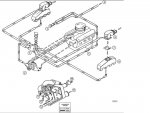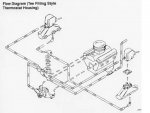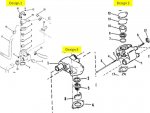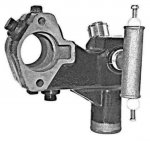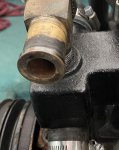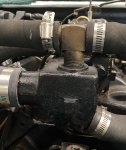I have a 94 Sea ray 200 Signature, and for the last 17 years the boat has been predominately in salt water. The engine block was changed approx 5-6 years ago when it was inadvertently ran out of oil, due to a loose oil filter(ugh). I've had overheating issues in the past (pre engine change), that have been remedied with impeller changes, thermostat, or thermostat housing replacements. After the engine change, the issues persisted on and off till the present.
In the last three years ive changed the impeller, exhaust manifolds, risers, thermostat, and temp gauge sensor. In 2018 i had the boat in the shop at the end of the season due to leaking drive oil.. They ended up changing some seals, and the complete impeller setup. Never had it back out that year, and then Hurricane Michael hit. Did some cosmetic damage to the boat, so it was late 2019 before i was back on the water. Noticed if i idled into the dock (about 800 rpm) for a long ways, my temp gauge would go up around 200-220 and i would get the overheat buzzer.
Went ahead this year and changed the Impeller again. If just sitting at idle it will still overheat, near 220. If i take it out of gear and bump idle to about 1100 rpm the temp will come down to about 180. I had a laser pyrometer with me last time, and took some temps when the boat gauge was reading over 200. The Thermostat housing was reading about 175, shooting the sensors in the housing showed about 169-175. The elbow risers were about 85, the manifolds were about 145. The riser elbows actually felt cool to touch, and a quick touch of the manifolds weren't too hot. running on the muffs it seems to be pumping water pretty well. Its making me wonder if im really having an overheat issue, or just a gauge issue? Im almost positive that the sensor is not OEM. Every year that goes by the salt water takes its toll on wiring and grounds, so i try to stay on top of it.. Just wondering if there were any ideas or suggestions? I've done a lot of researching thru forums but haven't found the answer yet.
In the last three years ive changed the impeller, exhaust manifolds, risers, thermostat, and temp gauge sensor. In 2018 i had the boat in the shop at the end of the season due to leaking drive oil.. They ended up changing some seals, and the complete impeller setup. Never had it back out that year, and then Hurricane Michael hit. Did some cosmetic damage to the boat, so it was late 2019 before i was back on the water. Noticed if i idled into the dock (about 800 rpm) for a long ways, my temp gauge would go up around 200-220 and i would get the overheat buzzer.
Went ahead this year and changed the Impeller again. If just sitting at idle it will still overheat, near 220. If i take it out of gear and bump idle to about 1100 rpm the temp will come down to about 180. I had a laser pyrometer with me last time, and took some temps when the boat gauge was reading over 200. The Thermostat housing was reading about 175, shooting the sensors in the housing showed about 169-175. The elbow risers were about 85, the manifolds were about 145. The riser elbows actually felt cool to touch, and a quick touch of the manifolds weren't too hot. running on the muffs it seems to be pumping water pretty well. Its making me wonder if im really having an overheat issue, or just a gauge issue? Im almost positive that the sensor is not OEM. Every year that goes by the salt water takes its toll on wiring and grounds, so i try to stay on top of it.. Just wondering if there were any ideas or suggestions? I've done a lot of researching thru forums but haven't found the answer yet.




















